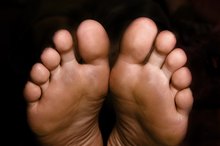Causes of Pain in the Big Toe and Ball of the Foot
The average adult takes about 9,000 steps per day. With each step, as the foot rolls forward, body weight shifts onto the ball of the foot as the toes extend in preparation for push-off. In most people, the big toe bears the bulk of the load during push-off. People often experience pain in this important and sensitive area of the foot. Common causes of pain in the big toe and ball of the foot include bunions, gout, "turf toe," sesamoiditis and arthritis.
If you are experiencing serious medical symptoms, seek emergency treatment immediately.
Bunion
Some people inherit a foot type in which the big toe angles toward the other toes rather than extending straight from the foot. Less commonly, this type of misalignment is the result of an injury. In either case, the misalignment results in excessive pressure and stress at the base of the big toe. A bunion is a firm bump that often forms at this point of stress. Bunions appear red and swollen and cause reduced mobility of the toe. The American Podiatric Medical Association warns that tight shoes can contribute to bunion formation in susceptible individuals.
- Some people inherit a foot type in which the big toe angles toward the other toes rather than extending straight from the foot.
- In either case, the misalignment results in excessive pressure and stress at the base of the big toe.
Gout
Diseases That Mimic Gout
Learn More
Gout is an inflammatory condition caused by deposition of uric acid crystals within a joint. It commonly affects the joint that connects the big toe to the foot. Gout causes severe pain, swelling and redness around the joint, making movement of the toe and weight bearing on the foot difficult. Thanks to improvements in gout treatments, fewer people suffer the severe destructive joint deformities from gout that were common in the past. Despite treatment improvements, the prevalence of gout in the U.S. has significantly increased, according to the American College of Rheumatology 2. Researchers believe an association exists between the increased prevalence of gout and another condition known as metabolic syndrome, which is characterized by obesity, insulin resistance, high blood pressure and elevated blood fats.
- Gout is an inflammatory condition caused by deposition of uric acid crystals within a joint.
- Gout causes severe pain, swelling and redness around the joint, making movement of the toe and weight bearing on the foot difficult.
Turf Toe
If the toes are firmly planted on the ground while the heel is raised, the downward force on the foot can bend the big toe backward beyond its normal range. If the force is great enough, it can cause the tearing of ligaments at the base of the toe. This injury was so frequently encountered by football and soccer players competing on artificial surfaces that it earned the moniker "turf toe." According to the American Academy of Orthopedic Surgeons, surgery is rarely necessary for turf toe, but a return to regular activities may take several days to weeks, depending on the severity of the injury 3.
- If the toes are firmly planted on the ground while the heel is raised, the downward force on the foot can bend the big toe backward beyond its normal range.
- According to the American Academy of Orthopedic Surgeons, surgery is rarely necessary for turf toe, but a return to regular activities may take several days to weeks, depending on the severity of the injury 3.
Sesamoiditis
Tips for Relieving MTP Joint Pain
Learn More
Sesamoid bones are small rounded bones that are embedded in tendons. They are seen in tendons that exert a great amount of pressure upon underlying surfaces. The kneecap, for example, is a large sesamoid bone in the quadriceps tendon. The underside of the foot near the base of the big toe typically has 2 sesamoid bones within tendons that flex the toe. Dancers and people who do a lot of jumping and landing on the balls of their feet may develop painful inflammation of the tendons surrounding these bones. The tenderness of sesamoiditis is most pronounced at the weight-bearing portion of the ball of the foot. In some cases, swelling or bruising can occur in that location.
- Sesamoid bones are small rounded bones that are embedded in tendons.
- The underside of the foot near the base of the big toe typically has 2 sesamoid bones within tendons that flex the toe.
Arthritis
Because the joint between the foot and the big toe is subject to repeated bending and loading, it is not surprising that this joint frequently develops arthritis. Arthritis may develop as a product of wear and tear over time. It can also develop as a consequence of the chronic misalignment seen with bunions or from the destructive inflammation of repeated gout attacks or even as a late effect of an injury like turf toe. This "secondary" arthritis can exacerbate pain in an already ailing toe.
- Because the joint between the foot and the big toe is subject to repeated bending and loading, it is not surprising that this joint frequently develops arthritis.
Related Articles
References
- Physical Therapy: Number of Pedometer-Assessed Steps Taken Per Day by Adults -- A Descriptive Meta Analysis
- American College of Rheumatology: Gout Prevalence Swells in U.S. Over Last Two Decades
- American Academy of Orthopedic Surgeons: Turf Toe
- Gray's Anatomy; Henry Gray
- Ferrari J. Bunions. BMJ Clin Evid. 2009;2009
- Roddy E, Menz HB. Foot osteoarthritis: latest evidence and developments. Ther Adv Musculoskelet Dis. 2018;10(4):91-103. doi:10.1177/1759720X17753337
- Sims AL, Kurup HV. Painful sesamoid of the great toe. World J Orthop. 2014;5(2):146-50. doi:10.5312/wjo.v5.i2.146
- Mccormick JJ, Anderson RB. Turf toe: anatomy, diagnosis, and treatment. Sports Health. 2010;2(6):487-94. doi:10.1177/1941738110386681
- American Academy of Orthopedic Surgeons. Stiff Big Toe (Hallux Rigidus).
- American Academy of Orthopedic Surgeons. Arthritis of the Foot and Ankle.
- Becker MA. Patient education: Gout (Beyond the Basics). In: UpToDate, Dalbeth N (Ed), UpToDate, Waltham, MA.
- Doherty M, Abhishek A. Clinical manifestations and diagnosis of osteoarthritis. In: UpToDate, Hunter D (Ed), UpToDate, Waltham, MA.
- Fields KB. Evaluation and diagnosis of common causes of foot pain in adults. In: UpToDate, Eiff P (Ed), UpToDate, Waltham, MA.
Writer Bio
Ron Rogers, a Washington chiropractor, has worked with local and national regulatory bodies in his profession and has provided consultation to the national chiropractic licensing board. He is recognized by the National Strength and Conditioning Association as a certified strength and conditioning specialist. Rogers' works have been published in several peer-reviewed professional journals, covering topics ranging from musculoskeletal diagnosis to research-based rehabilitation strategies.







